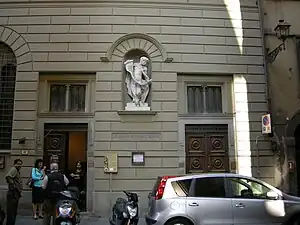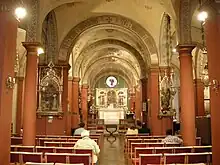
Saint Mark's English Church is an Anglican church in Florence, Italy.
The church forms part of the chaplaincy[lower-alpha 1] of St Mark's Florence with Holy Cross Bologna, in the Diocese in Europe of the Church of England.[1]
The last permanent chaplain at St Mark's was Father William Lister, who retired at the end of 2020.[2] The current chaplain is a locum replacement.[3] Prior to the COVID-19 pandemic in 2020–2021, the average congregation was about 100. The church ministers to the homeless in Florence. It also has vibrant music and cultural programmes, with annual resident choirmaster and organ master interns, who provide vocal and instrumental concerts and recitals with visiting musicians, along with sacred and devotional music at Sunday mass and evensong. The St Mark's Cultural Association offers a Book Club and Armchair Drama Club; Florence Writers offers discussions and workshop on writing, literature, and poetry. Opera at St Mark's has been offering opera performances by its resident opera company for more than ten years.[4]
History
St Mark's was founded by the Reverend Charles Tooth as a centre of worship for Anglo-Catholic members of the Anglican Church in Florence. He started a house church at 1 Via dei Serragli in 1877 to teach Anglo-Catholic principles and celebrate the Eucharist daily during the week. In 1880,[5] Tooth purchased a 15th-century palazzo to meet the new congregation's needs. John Roddam Spencer Stanhope designed and created the wall and ceiling decorations at his own expense.[6] The first Eucharist was celebrated there on 1 May 1881, although chaplain and church were not licensed for service by the bishop until 1884.[7] The premises were extended by the purchase of 16 Via Maggio in 1906.[8]
The church was damaged by the 1966 flood of the Arno, resulting in the loss of George Frederick Bodley's 19th-century stencil work on the lower walls, although some survived behind a display cabinet.[9]
St Mark's was the second Anglican church to be built in Florence. The British community in Florence has a long history[10] and the chaplaincy began in the late 1820s. The first church, Holy Trinity, opened in the 1840s. Rebuilt in the 1890s, Trinity Church on the Via Lamarmara, is today a Waldensian Church.
Architecture

Exterior
The white marble statue in the niche over the main door is The Apotheosis of Saint Mark (2007–2008) by Jason Arkles.[11] This is the first work by an American sculptor to have a permanent public location in Florence.[12] It was commissioned by the then priest Fr Lawrence MacLean, who worked closely with Arkles on this project. They were able to find and use the same marble from which Michelangelo's David had once been carved.
Interior
The building was altered by Tooth, who turned the ground floor into a church with nave, aisles, transept and chancel, about 90 feet (27 m) long[5] and seating 400.[4] The interior is decorated in the Pre-Raphaelite style and the upper reaches of the church have floral motifs which the art historian Berenice Schreiner has descrived as having "a wonderful sense of naturalism".[5]
Notes
- ↑ A chaplaincy in this context is rather like a parish but with a more fluid membership. In this case it mainly serves three groups of English speakers: expatriates, students and tourists in Tuscany and Emilia-Romagna, with participants often travelling long distances.[lower-alpha 2]
References
- ↑ "Chaplaincy". Florence: St Mark's English Church. Archived from the original on 5 January 2014. Retrieved 4 January 2014.
- ↑ "Resignations and Retirements". Church Times. London. 24 July 2020. Archived from the original on 5 June 2021. Retrieved 6 June 2021.
- ↑ "Staff and Ministry". Florence: St Mark's English Church. Archived from the original on 5 January 2014. Retrieved 4 January 2014.
- 1 2 Brucato, Haley (11 April 2013). "More than Meets the Eye". The Florentine (181). Archived from the original on 9 May 2013. Retrieved 1 July 2013.
- 1 2 3 Schreiner 2001, p. 90.
- ↑ Schreiner 2001, p. 90: quoting Varty, H. A. (1934). A Short History of St Mark's English Church. Unpublished. p. 15.
- ↑ Mittler 2011, p. 49.
- ↑ "History". Florence: St Mark's English Church. Archived from the original on 12 July 2011. Retrieved 21 June 2013.
- ↑ Schreiner 2001, pp. 90–91.
- ↑ Mittler 2007.
- ↑ "Apotheosis Of Saint Mark". Monuments. Jason Arkles. Archived from the original on 26 January 2020.
- ↑ "Modern Art in Florence". LdM News. Florence: Lorenzo de' Medici School. Archived from the original on 22 February 2014.
Citations
- Mittler, Penny (2007). "The Church of England Chaplaincies in Florence since 1820" (PDF). Florence: St Mark's English Church. Archived (PDF) from the original on 11 January 2014. Retrieved 20 January 2014.
- Mittler, Penny (2011) [first published 2007]. "Only Connect: A Case Study of the Influence of the English Church and the Non-Catholic Cults in the Florence of the Risorgimento". In Faltin, L.; Wright, M. (eds.). The Religious Roots of Contemporary European Identity. London: Continuum Press. pp. 40–52. ISBN 978-1-4411-9571-5.
- Schreiner, Berenice (Spring 2001). "The Collaboration of G. F. Bodley & J. R. Spencer Stanhope in Florence 1892–1904" (PDF). Journal of William Morris Studies. 14 (2): 90–95. ISSN 0084-0254.
External links
- Official website
- Previous website at the Wayback Machine (archived 14 January 2012)